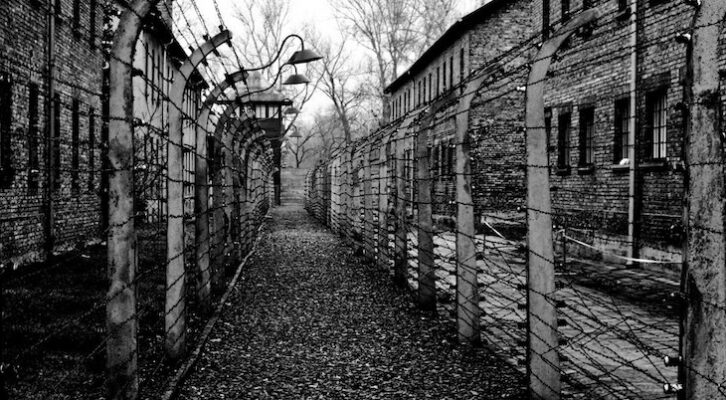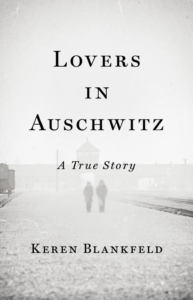
Uncovering the Incredible Story of a Romance Between Two Prisoners in Auschwitz
Keren Blankfeld on Researching a Gripping Love Story and the Challenges of Writing About Someone Who Isn't There
When I took a train to Levittown, Pennsylvania in August of 2018, my plan was to interview David Wisnia, a Polish Jew who’d arrived in Ellis Island in 1949. By the time he was 15, David was an orphan, alone in the world, fleeing Nazis. By sixteen, he was a prisoner in Auschwitz, forced to carry corpses in the most notorious Nazi death camp. And suddenly at eighteen he was clad in full American uniform, an interpreter for the US army.
On its own, David’s saga was incredible. As I was about to leave the interview, David casually mentioned that he had a secret girlfriend while he was in Auschwitz. A secret girlfriend who was a graphic designer at the camp. She was a remarkable woman, he said, a “special prisoner” by the name of Zippi. I sat back down, my recorder still running. In fact, he said, he’d seen her a couple of years ago, in her home in Manhattan. For the first time in 72 years.
David was 91 years old. I wouldn’t have blamed him for misremembering his time in Auschwitz, for mixing fact and fantasy. Except Zippi Tichauer was very real.
I spent my train ride home Googling Zippi, whom I learned was a Slovakian Jew who’d passed away in Manhattan just two months earlier. David had mentioned a book about her. The book, edited by Jürgen Matthäus, the director of research at the United States Holocaust Museum in Washington, DC, included essays by five historians who’d interviewed Zippi, each from a different perspective. Once I began reading, I was hooked.
*
On paper, Zippi came across as strong, funny, and decades ahead of her time. She was raised by progressive grandparents to be strong and ambitious. Zippi was intent on becoming a licensed graphic designer, despite having two strikes against her: she was Jewish and a woman. But when the Nazis arrived in Bratislava the question was moot.
Zippi was among the first Jewish women transported to Auschwitz. Her trajectory in Auschwitz-Birkenau was astonishing: one moment she was at the brink of death, the next she had her very own office in the camp. Zippi had close contact with some of the most notorious Nazis, she’d been enmeshed in various underground movements, and become close to some of the camp’s greatest resisters. She’d had a hand in creating the camp’s women’s orchestra (yes, there were multiple orchestras in Auschwitz, as part of the camp’s camouflage to the outside world). She’d personally saved many women’s lives.
The more I learned, the more questions I had. I knew I had to pursue this story, see if there really was something there. But it would have to be a write-around, meaning I’d have to report it without any access to one of my main characters.
My first instinct was to interview family and friends. Unfortunately, Zippi’s husband had died years earlier and they had no children. Zippi’s only brother, Sam, had died in Sydney, Australia, although he did leave an oral testimony behind, which would become invaluable. Considering that Zippi had died in her 90s, I didn’t imagine she had many friends alive.
Fortunately, Zippi also recorded several oral testimonies. Her first interview was recorded in 1946 by a Latvian American psychologist who’d been collecting testimonies from survivors across Europe. Over the years, Zippi connected with dozens of scholars. Often, her interviews were taped and available through archives. Zippi was meticulous in describing the mechanics of Auschwitz. She was adamant that she had one of the best vantage points at the camp: she had the prisoners’ perspectives, but she also knew how the Nazis functioned. Listening to Zippi speak, I heard a confident, intelligent woman, at times impatient with her interviewer.
I then called Jürgen Matthäus, author of Approaching an Auschwitz Survivor, and every historian I could find who’d interviewed Zippi—from New York City to Washington, DC, to London and Sydney. All were understandably protective of Zippi. She’d never spoken with the media. Zippi disdained what one historian said she called “the business of the Holocaust.” All she wanted was to set the record straight. Plus, my introduction to Zippi, her relationship with David, was a brief interlude from a past life, a romance that Zippi seemed intent on forgetting.
But when I came across an audio recording of Zippi and David remembering their romance in Auschwitz, I got the chills. The romance, albeit short-lived, was monumental. In order for them to survive it was invisible by design: a look, a barely perceptible nod, a tiny note. In a place where prisoners experienced constant grief and violence, lived with relentless hunger and pain, David and Zippi had their nominal interactions, and eventually brief trysts, to anticipate. While Nazis aimed to convert humans into numbers, they resisted, insisting upon their humanity.
In today’s reality where news stories have become daily horror stories, here was a story of two people in an impossible situation who proved that human connection can restore faith. David and Zippi’s story touched me profoundly. And the more I learned about Zippi, the more I felt that I couldn’t leave her story to obscurity. Zippi’s legion of loyal historians agreed.
*
As a journalist, one of the first things we’re taught is the old adage: “if your mother tells you she loves you, check it out.”
I scoured archives in search of testimony from people who’d been imprisoned with Zippi. Several survivors corroborated Zippi’s stories. I converted old mini-cassette tapes and strained to listen to her somewhat garbled voice beneath the white noise. The stories she told were always consistent. I read dozens of survivors’ memoirs. The late Susan Cernyak-Spatz, author of Protective Custody: Prisoner 34042: A Holocaust Survivor Memoir, cited an unpublished manuscript by Zippi Tichauer in its footnotes.
I contacted Jürgen Matthäus, her closest confidant, and Zippi’s makeshift family of historians with whom she spoke with on nearly a weekly basis. Not one had ever heard her mention the manuscript. She’d written a brief article in 1989 for the journal Voice of the Woman Survivor, but that was all they knew of.
I called Zippi’s two great-grandnieces in Prague, who by then I’d interviewed a few times. I asked one of Zippi’s oldest friends, from back in her days in Bratislava. They knew nothing about a manuscript. I began to think of it as a phantom manuscript.
I reached out to Susan Cernyak-Spatz’s daughter, who in turn connected me with Anabel Aliaga-Buchenal, chair of the Department of Language and Culture Studies at UNC Charlotte. Aliaga-Buchenal, a colleague of the late Cernyak-Spatz’s, was organizing her papers. She knew nothing about the manuscript. I’d reached a dead end. By then I had already written what I thought was close to a final draft of the book. I moved on.
In today’s reality where news stories have become daily horror stories, here was a story of two people in an impossible situation who proved that human connection can restore faith.
About fourteen months later, I was jogging in Prospect Park when Aliaga-Buchenal sent me a message that stopped me; I immediately called her. She’d found The Manuscript inside an unmarked cardboard box, she said, sounding as breathless as I was. I held my breath and asked how soon I could get a copy. She promised to photograph a few pages for me and put a copy in the mail as soon as she could. I sprinted home. Within an hour she’d scanned 153 pages on her phone and sent them all.
I devoured each page and sent the manuscript to a handful of historians who knew Zippi well. Much of the material confirmed what Zippi had conveyed to historians in testimonies and interviews. One historian, ecstatic, wrote that she felt as though she were hearing Zippi’s voice again. Another was wary: why, he wondered, had Zippi never published the manuscript or even mentioned it? Perhaps she didn’t like the way it was edited? Perhaps it was augmented by its editors? The facts lined up but the question was editorial. He suggested I use the manuscript as a source, but not quote directly from it, since we didn’t know how heavily it was edited. This made sense to me. Still, through the manuscript, Zippi emerged even more clearly.
I pictured Zippi biting into an apple with a secret message.
I could see her Zippi watching two SS officers ride their majestic horses, reminding her of a world with beauty.
I saw Zippi protecting a young, emaciated girl, in much the way she’d been protected during her initial days at the camp.
*
Over the course of four years I thought about Zippi every day. Over and over, I heard the recording of her voice as a young, homeless girl in a displaced persons camp, trying to explain to an American in German what she’d lived through. Again and again, I heard her deepened voice, recorded decades later at her Manhattan apartment. Zippi, offering food and water while in conversation with a friend as they gave testimony together, gossiping about acquaintances, extolling the virtues of codfish oil, leaping in to correct the interviewer. In a video, I watched her in her sofa bed, unable to walk, widowed, mostly deaf and blind singing klezmer with a musician. I listened to her voice dip back into her youth, as she reminisced with an old lover.
I still think of Zippi every day. Near my desk I have a photograph of my two grandmothers, Helena and Zipora. Zippi’s full name is Helen Zipora Spitzer. Both my grandmothers were Holocaust survivors, they were also fighters, who lived through heartbreak and loss, who built new lives for themselves. In writing Zippi’s story, I somehow also felt closer to them.
I didn’t set out to write about Zippi. Looking back, I don’t know how I could not write about Zippi.
_________________________________________

Lovers in Auschwitz: A True Story by Keren Blankfeld is available now via Little, Brown.
Keren Blankfeld
Keren Blankfeld is a long-form journalist with a special interest in investigative narrative nonfiction. A former staff writer for Forbes Magazine, her stories have appeared in the New York Times, Forbes, Reuters, The Toronto Star, and others. She teaches reporting and writing at the Columbia Graduate School of Journalism and has also taught at the New York University’s Graduate School. She has been a guest on CNN, BBC World News, and E! Entertainment. In 2013, Keren served as a creative executive at New Regency Productions, where she worked with screenwriters and playwrights to develop material for movies and TV shows. She holds a B.A. in International Relations and English from Tufts University and an M.S. in Journalism from Columbia University. She now lives in New York with her husband and two sons.



















